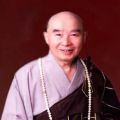Chapter 5: The Integration of Confucianism and Buddhism Buddhism successfully merged into Chinese culture; they became inseparable. The basic concept that they share is to give up one's own interest for the sake of others. Confucianism and Buddhism advocate the enhancement and glorification of filial piety, the respect and devotion of an individual for their parents and teachers. Filial piety is a major element in accomplishing world peace.
What is education? It is the meaning and the value of human life, the relationships between human beings as well as those between humans and the universe. Confucian teaching encompasses three main points. First, it is important to understand the relationship between humans, once this is understood we will learn to love people. Second, it is important to understand the relationship between humans and heaven, once this is understood we will learn to respect heavenly beings and spirits. Third, it is important to understand the relationship between humans and the environment, once this is understood we will learn to take care of the environment and to appreciate every single thing around us. There are four studies within Confucian teachings: virtue, speech, skills for earning a living and the arts. The teaching of virtue is the core of Confucianism; it is absolutely crucial, for without morality and proper conduct we become selfish and concerned only with ourselves at the expense of society. Such behavior can result in world chaos. Today, our education has lost that emphasis. Schools only teach skills that are superficial and not the root of education. When the root is rotten, it shakes the foundation of society and causes the chaos that we are experiencing today. Elementary schools are like the root of education: junior highs, high schools, and colleges are the flowers and leaves. Teachers can start teaching filial piety to our children as early as possible.
By looking at the way Chinese characters were created, we cannot but admire our ancestor's high level of wisdom. We thank them for having given us something that is so valuable and exquisite. The Chinese character "piety" embraces the spirit of Buddhism and the foundation of education as it is a combination of the characters for "old" and "son." Nowadays, people talk about the generation gap between parents and children, which is something traditional families did not have. In the Chinese tradition, not only are father and son one unit; grandfathers and grandsons, etc. are all part of the same continuum. This is a unique concept. Westerners often ask why Chinese people pay respect to ancestors since we barely know them. The remembrance of our ancestors is the foundation of Confucianism and Buddhism, which is the source of harmony in society and peace in the world.
Today everyone longs for world peace, but we need to start from the foundation of filial piety to obtain it. Buddhism emphasizes unconditional compassion for all sentient beings in the universe and beyond; in the past, present and future. The continuum of time and space is inseparable from oneself, for We Are All One Entity. One does not find this extensive concept in religion. "Thus Come One", one of the ten names for Buddha, stands for an enlightened being, which is our basic nature, and also the essence of the universe and human life. This concept is embodied by the Chinese character "piety" and the name of Amitabha Buddha in the Pure Land School. The names may be different but the meanings are the same: unconditional love for all beings that surpasses space and time.

